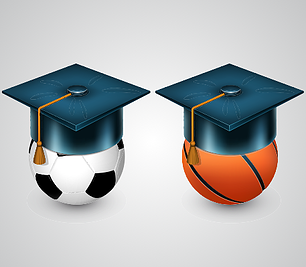Recently, a parent contacted MyGuru about ACT tutoring. Her daughter’s first session with the tutor went well, but because she was scheduled to take a practice ACT test...
Test Optional isn't for Aspiring College Athletes

Most high school athletes looking to play in college can readily rattle off their relevant statistics, be it best times, yards rushing, batting averages, or goals. They'll be able to tell you how often they qualified for the various all-state honors available. But far too many couldn't tell you if they would be an NCAA D1 qualifier for their sport.
A "qualifier" is an athlete who has qualified to participate in NCAA D1 sports by meeting all academic requirements. This means that the athlete has met the minimum required GPA in 16 core classes with a matching ACT or SAT score. D1 uses a sliding scale to determine the require test scores--the lower your GPA, the higher test score required.
Athletes shouldn't be misled by the increasing number of schools announcing that they're going "test-optional." If you want to play on a D1 or D2 team in the NCAA, you ARE going to be submitting your test scores not just to the school, but to the NCAA eligibility center as well.
Unfortunately, plenty of athletes spend their first years in high school not worrying about these requirements. It's often a rude wake-up call when the first thing a college coach asks for is the athlete's GPA and test scores. College coaches aren't going to waste their time recruiting someone who won't qualify.
And it's not just the NCAA academic standards athletes need to worry about. Individual conferences and schools can and do set their own higher minimum standards. Ivy League athletes have to deal with the Academic Index which is also based on GPA and test scores. However, it isn't used just to evaluate individual athletes but to measure the over all level of all student-athletes in the sport. In other words, Ivy League coaches can't just recruit from the lowest acceptable scores.
Given that most athletes don't become aware of these requirements until sometime after their sophomore year, it can be an uphill struggle to improve their GPA. After all, two years of grades have been set. Or worst yet, students may find out that some of the classes they have taken won't qualify for core classes. In any case, shifting a GPA is a long-term proposition.
However, relatively speaking, preparing for the ACT or SAT test is something that can be done over the summer with potentially dramatic effect. For students looking to play at the D1 level, a combined 200 points difference for Critical Reading and Math on the SAT is worth half a grade point. For those interested in playing for the NAIA, students can use test scores instead of GPA or class rank to meet minimum requirements.
Improving GPA and test scores can actually be most beneficial to athletes looking to play at the D3 level. While D3 institutions can not provide athletic scholarships, many give out generous merit scholarships. Athletes may find it easier to move into the 80th percentile for GPA and test scores then being in the top five percent of high school players who make it to college. In any case, high school athletes need to take their academic preparation just as seriously as their athletic training.
Michelle Kretzschmar is the creator of the DIY College Rankings Spreadsheet which contains information on over 1,500 colleges that families can use to identify schools best for them. She is also very interested in college graduation rates and has created a 50-50 list of colleges that accept at least 50% of their applicants and have at least a 50% graduation rate. Michelle received her Bachelor's Degree in Plan II and History and Masters in Public Affairs from the University of Texas at Austin with research focusing on high school dropouts.

